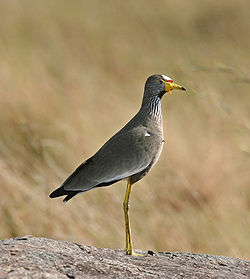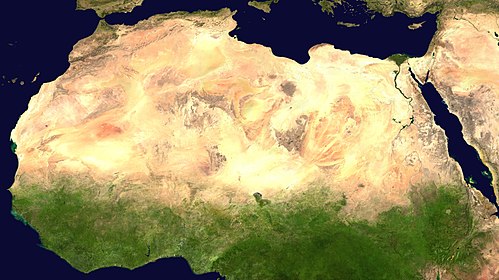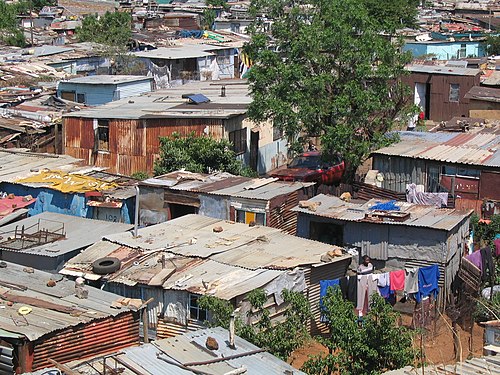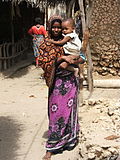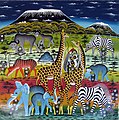Portal:Africa



Africa is the world's second-largest and second-most populous continent after Asia. At about 30.3 million km2 (11.7 million square miles) including adjacent islands, it covers 20% of Earth's land area and 6% of its total surface area. With nearly 1.4 billion people as of 2021, it accounts for about 18% of the world's human population. Africa's population is the youngest among all the continents; the median age in 2012 was 19.7, when the worldwide median age was 30.4. Based on 2024 projections, Africa's population will exceed 3.8 billion people by 2100. Africa is the least wealthy inhabited continent per capita and second-least wealthy by total wealth, ahead of Oceania. Scholars have attributed this to different factors including geography, climate, corruption, colonialism, the Cold War, and neocolonialism. Despite this low concentration of wealth, recent economic expansion and a large and young population make Africa an important economic market in the broader global context, and Africa has a large quantity of natural resources.
Africa is highly biodiverse; it is the continent with the largest number of megafauna species, as it was least affected by the extinction of the Pleistocene megafauna. However, Africa is also heavily affected by a wide range of environmental issues, including desertification, deforestation, water scarcity, and pollution. These entrenched environmental concerns are expected to worsen as climate change impacts Africa. The UN Intergovernmental Panel on Climate Change has identified Africa as the continent most vulnerable to climate change.
The history of Africa is long, complex, and varied, and has often been under-appreciated by the global historical community. In African societies the oral word is revered, and they have generally recorded their history via oral tradition, which has led anthropologists to term them "oral civilisations", contrasted with "literate civilisations" which pride the written word. African culture is rich and diverse both within and between the continent's regions, encompassing art, cuisine, music and dance, religion, and dress.
Africa, particularly Eastern Africa, is widely accepted to be the place of origin of humans and the Hominidae clade, also known as the great apes. The earliest hominids and their ancestors have been dated to around 7 million years ago, and Homo sapiens (modern human) are believed to have originated in Africa 350,000 to 260,000 years ago. In the 4th and 3rd millennia BCE Ancient Egypt, Kerma, Punt, and the Tichitt Tradition emerged in North, East and West Africa, while from 3000 BCE to 500 CE the Bantu expansion swept from modern-day Cameroon through Central, East, and Southern Africa, displacing or absorbing groups such as the Khoisan and Pygmies. Some African empires include Wagadu, Mali, Songhai, Sokoto, Ife, Benin, Asante, the Fatimids, Almoravids, Almohads, Ayyubids, Mamluks, Kongo, Mwene Muji, Luba, Lunda, Kitara, Aksum, Ethiopia, Adal, Ajuran, Kilwa, Sakalava, Imerina, Maravi, Mutapa, Rozvi, Mthwakazi, and Zulu. Despite the predominance of states, many societies were heterarchical and stateless. Slave trades created various diasporas, especially in the Americas. From the late 19th century to early 20th century, driven by the Second Industrial Revolution, most of Africa was rapidly conquered and colonised by European nations, save for Ethiopia and Liberia. European rule had significant impacts on Africa's societies, and colonies were maintained for the purpose of economic exploitation and extraction of natural resources. Most present states emerged from a process of decolonisation following World War II, and established the Organisation of African Unity in 1963, the predecessor to the African Union. The nascent countries decided to keep their colonial borders, with traditional power structures used in governance to varying degrees. (Full article...)
Selected article –
The Kennedy Airlift was started in 1959 by a 28-year-old Kenyan, Tom Mboya, who sought support for promising Kenyan students to get college and university educations in the United States and Canada. It brought hundreds of students from East Africa from 1959 to 1963 and was supported by many North American educational institutions, foundations, and individuals such as the African American Students Foundation (AASF) and African Americans including Harry Belafonte, Jackie Robinson, Sidney Poitier, and Martin Luther King Jr. It got its popular nickname in September 1960 when Senator John F. Kennedy in a close presidential campaign arranged a $100,000 donation from the Joseph P. Kennedy Jr Foundation to cover airfare for the autumn 1960 group of East African students just as the program was running out of funds. (Full article...)
Featured pictures –
Did you know (auto-generated) -

- ... that 555 Edgecombe Avenue, once named for a British soldier and occupied entirely by white Americans, later attracted notable African Americans like Paul Robeson and Count Basie?
- ... that land for a library built for African Americans in Virginia was donated by Pope Pius XII?
- ... that Togo's abortion law was one of the first in Africa to allow abortion in the case of rape?
- ... that after anti-apartheid activist David Rabkin was sentenced to prison in South Africa, he gave the courtroom the clenched-fist black power salute?
- ... that Roland Jefferson, the first African-American botanist to work at the U.S. National Arboretum, helped preserve the famous flowering cherry trees in Washington, D.C.?
- ... that Olive MacLeod journeyed 6,000 km (3,700 mi) through Africa in 1910–1911 to visit her murdered fiancé's grave, and wrote a book based on her observations?
Categories
Selected biography –
Amanirenas (also spelled Amanirena), was queen regnant of the Kingdom of Kush from the end of the 1st century BCE to beginning of the 1st century CE. She is known for invading Roman occupied Egypt and successfully negotiating the end of Roman retaliation, retaining Kushite independence.
Her full title was Amnirense qore li kdwe li ("Ameniras, qore and kandake"). Meroitic, the indigenous language of the kingdom of Kush, remains undeciphered; however, inscriptions giving Queen Amanirenas the title of "qore" as well as "kandake" suggest that she was an individually ruling queen. (Full article...)
Selected country –
 |
 |
||

| |||
Sierra Leone, officially the Republic of Sierra Leone, is a country in West Africa. It is bordered by Guinea on the north and Liberia on the south, with the Atlantic Ocean on the west. The name Sierra Leone was adapted from the Portuguese name for the country: Serra Leoa, literally "Lion Mountain Range".
During the 18th century, Sierra Leone was an important center of the transatlantic trade in African slaves. The capital Freetown was founded in 1787 by the Sierra Leone Company as a home for formerly enslaved African Americans who had fought for the British in the American Revolutionary War. In 1808, Freetown became a British Crown Colony, and in 1896, the interior of the country became a British protectorate.
The Crown Colony and Protectorate joined and gained independence in 1961. From 1991 to 2002, Sierra Leone suffered greatly under the devastating effects of rebel activities, which were stopped by UN and British forces disarming 17,000 militia and rebels. Sierra Leone has been at peace since 2002. (Read more...)
Selected city –
Harare (/həˈrɑːreɪ/ hə-RAR-ay), formerly Salisbury, is the capital and largest city of Zimbabwe. The city proper has an area of 982.3 km2 (379.3 sq mi), a population of 1,849,600 as of the 2022 census and an estimated 2,487,209 people in its metropolitan province. The city is situated in north-eastern Zimbabwe in the country's Mashonaland region. Harare is a metropolitan province that incorporates the municipalities of Chitungwiza and Epworth. The city sits on a plateau at an elevation of 1,483 metres (4,865 feet) above sea level, and its climate falls into the subtropical highland category.
The city was founded in 1890 by the Pioneer Column, a small military force of the British South Africa Company, and was named Fort Salisbury after the British Prime Minister Lord Salisbury. Company administrators demarcated the city and ran it until Southern Rhodesia achieved responsible government in 1923. Salisbury was thereafter the seat of the Southern Rhodesian (later Rhodesian) government and, between 1953 and 1963, the capital of the Central African Federation. It retained the name Salisbury until 1982 when it was renamed Harare on the second anniversary of Zimbabwe's independence from the United Kingdom. The national parliament moved out of Harare upon completion of the New Parliament of Zimbabwe in Mount Hampden in April 2022. (Full article...)
In the news
- 14 April 2025 – Gaza war
- President of Indonesia Prabowo Subianto tours the Middle East to seek support from the United Arab Emirates, Turkey, Egypt, Qatar, and Jordan for his proposed plan to temporarily evacuate 1,000 Palestinians from the Gaza Strip to Indonesia. (Indonesia Business Post)
- 13 April 2025 – Boko Haram insurgency
- Eight people are killed and a dozen others are injured after a roadside bomb suspected to be planted by Islamic extremists hits a bus on the Damboa-Maiduguri highway in Borno State, Nigeria. (AP)
- 13 April 2025 – 2025 Gabonese presidential election
- Gabonese military leader Brice Oligui Nguema wins the presidential election with more than 90% of the vote as an independent politician. (BBC News)
- 12 April 2025 – Sudanese Civil War
- Siege of El Fasher
- Zamzam and Abu Shouk refugee camp massacres
- At least 100 people, including 20 children, are killed in Rapid Support Forces attacks on Al-Fashir and two nearby displacement camps in North Darfur, Sudan, according to the United Nations. (Hindustan Times)
Updated: 17:05, 14 April 2025
General images -
Africa topics
More did you know –
- ... that Liberia College in the country of Liberia was authorized by the legislature in 1851, but did not start classes until 1863?
- ... that the forced removal of 700,000 people from slums in Zimbabwe in 2005 was called "a crime against humanity" by the UN?
- ... that the supreme god of the southern African Bushmen is Cagn, a trickster who shapeshifts into a praying mantis?
- ... that Bahá'í Faith in Niger began during a period of wide scale growth in the religion across Sub-Saharan Africa near the end of its colonial period?
Related portals
Major Religions in Africa
North Africa
West Africa
Central Africa
East Africa
Southern Africa
Associated Wikimedia
The following Wikimedia Foundation sister projects provide more on this subject:
-
Commons
Free media repository -
Wikibooks
Free textbooks and manuals -
Wikidata
Free knowledge base -
Wikinews
Free-content news -
Wikiquote
Collection of quotations -
Wikisource
Free-content library -
Wikispecies
Directory of species -
Wikiversity
Free learning tools -
Wikivoyage
Free travel guide -
Wiktionary
Dictionary and thesaurus









